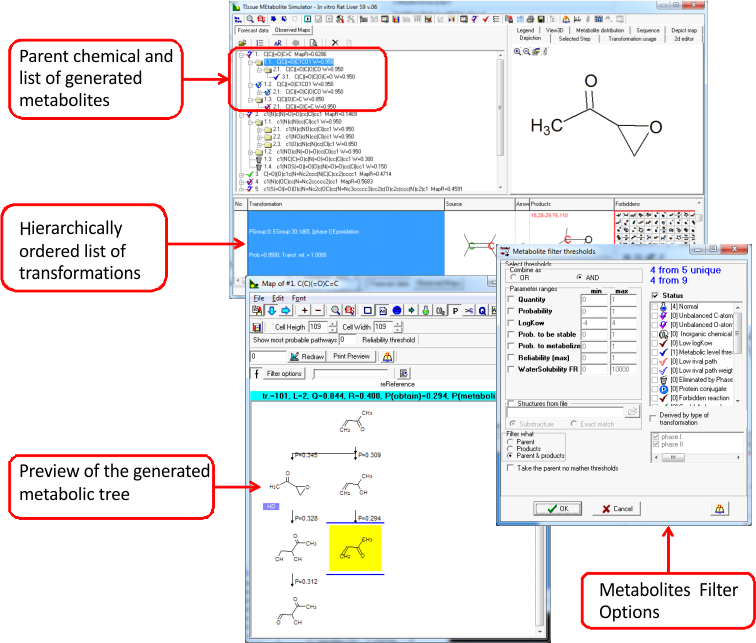In vivo Rat Metabolism
Endpoint
The in vivo rodent metabolic simulator (transformation table) reproduces and predicts the metabolic pathways of xenobiotic chemicals in vivo in rodents (mostly rats).
Data
The metabolism training set contains experimentally observed (documented) in vivo metabolic pathways for 647 structurally different parent chemicals, and 4382 observed metabolites compiled into a searchable electronic database. Published data on the invivo metabolism of these chemicals in rodents (mostly rats) collected mainly from research publications in scientific journals and from some websites were extracted and introduced into an electronic database [1].
Model
The simulation of metabolism is focused on the correct reproduction of experimentally observed metabolites [2]. The current in vivo rat metabolic simulator represents electronically designed set of 609 structurally generalized, hierarchically arranged biotransformation reactions. These molecular transformations are characteristic for the in vivo metabolism in rats. Each transformation in the simulator consists of source and product structural fragments, and inhibiting "masks". A probability of occurrence is ascribed to each transformation, which determines its hierarchy in the transformation list. Thus the modeling is based on the set of principal molecular transformations, and the in vivo "logic" of the commonly observed xenobiotics metabolism in living rats.
The following types of molecular transformations are included into in vivo simulator:
- 26 abiotic (non-enzymatic) reactions. The highest priority (probability of occurrence) is assigned to these reactions. This subset of reactions includes also transformations of highly-reactive functional groups and intermediates, such as tautomerizations, arene epoxide rearrangements to phenols, etc. which occur spontaneously.
- 479 enzymatic phase I transformations such as aliphatic C-oxidation, aromatic C hydroxylation, oxidative N- and O-dealkylation, epoxidation, ester and amide hydrolysis, carbonyl group reduction, nitro and azo group reduction, N-hydroxylation, oxidative deamination, beta-oxidation, ring cleavage, hydrolytic cleavage, aromatization, decarboxylation, dehalogenation, etc.
- 104 enzymatic phase II transformations, such as glucuronidation, sulfation, glutathione and mercapturic acid conjugation, N-acetylation, etc., which, unlike the in vitro systems, are believed to occur with high priority in vivo.
Domain
The derivation of the structural domain of simulator is based on atom-centered fragments.
Statistics
Average sensitivity (probability that the metabolite is predicted, given that the metabolite is truly observed) is 77 %.
Average predictability (probability that the metabolite is truly observed, given that the metabolite is predicted) is 46 %.
References
1. Kolanczyk R. C,
P. Schmieder, W. J. Jones, O. G. Mekenyan, A. Chapkanov, S.
Temelkov, S. Kotov, M. Velikova, V. Kamenska, K. Vasilev, G.
D.Veith, MetaPath: An Electronic Knowledge Base for Collating,
Exchanging and Analyzing Case Studies of Xenobiotic Metabolism,
Regul. Toxicol. Pharmacol. 63(1) (2012), 84 - 96.
2. Mekenyan, O., S. Dimitrov, T. Pavlov, G.
Dimitrova, M. Todorov, P. Petkov, S. Kotov, Simulation of Chemical
Metabolism for Fate and Hazard Assessment. V. Mammalian Hazard
Assessment, SAR QSAR Environ Res. 23(5-6) (2012), 553 - 606.

